
Evolution of computer Graphics
Evolution of computer Graphics
CGA > VGA > SVGA > 3DFX, the 1990’s saw quantum leaps in computer graphics, the likes of which will probably never be seen again.
Pioneer days
Time in the sim community "began" in the early 1980's with the availability of affordable personal computers.
In those days 64K was regarded as a generous amount of RAM...that's 64K not 64 MEG! Programs were loaded via cartridges, tape drives or 5 1/4 inch floppies and colour video display was just catching on.
The 8 bit family (Atari 400/800, Commodore Vic-20, C-64, C-16, C Plus 4, Osbourne, Timex Sinclair) had basic sound capabilities and up to 16 colours, which was far beyond the capability of any MS-DOS based PC at the time. Our earliest computer flight fantasies were satisfied by classics such as "Choplifter", a 2-D Platform game which tasked you with manouevering past enemies to rescue hostages. It was sweaty palms time as you waited for those little people to climb aboard one by one!
Pseudo-3D appeared in the arcades and then in short order on 8-bit home computers in Zaxxon, a scrolling game which erquired you to manouever past deadly obstacles in a 3rd person .perspective view. Riveting stuff for the time!
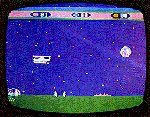
Choplifter
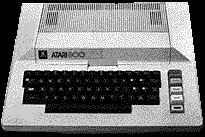
ATARI 800
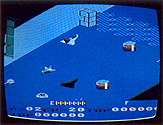
Zaxxon
Atari ST, Choplifter and Zaxxon images were provided by the Digital Antic Project.
16 bit revolution
In 1985 Atari Corporation introduced its new 16-bit computer system in the 520ST.
520 referred to the whopping 520 K of memory and ST for Sixteen/Thirty Two bit processor. The 520ST represented a major step forward in computer and operating system design. It had a Graphic user interface (GUI) built in ROM known as TOS (The Operating System or Tramiel Operating system).
At the same time Commodore bought out the Amiga series (16 and 32 bit Motorola processor) which moved to full 32 bit in 1989. These computers had dedicated graphics chipsets with up to 640 x 400 resolution. They could play midi files, sampled sounds and display 320 x 200 colour graphics.
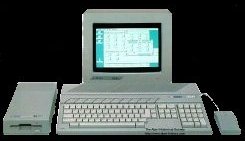
Atari 520 ST picture courtesy of the Atari Historical Society Virtual Museum
VGA: an amazing 256 colours
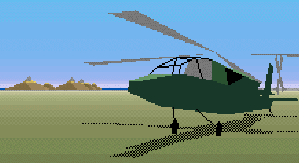
This screenshot from ATAC released in 1992, tells us a lot about the state of PC graphics back then.
Firstly, the aircraft. It is constructed of a few polygons mapped to one colour, a couple of wire-frames in the cockpit and landing gear and two animated areas in the main and tail rotors.
The sky is one colour with gradations near the horizon. The terrain is flat with bands of colour punctuated by pyramidal mountains constructed in tiers and repeated.
Today this looks extremely basic, but in 1992 it was complex enough to bring many home PCs to their knees.
In about 1991, PC DOS based 486 processors and Sound Cards gave PC's comparable sound and graphics capabilites and many of the gaming community (mysellf included) switched platforms.
PC video modes during the 1980's were:
- 2 colour Hercules
- 4 colour CGA
- 16 colour Tandy 1000
- 18 colour EGA
- 258 colour VGA
Super VGA: Military level visuals in a home computer
By 1994 SVGA (Super VGA) was supported by the S3 chipset which enabled graphics resolutions of 640 x 400 and higher.
Also the CPU clock speeds had increased from 8Mhz in the Atari ST to 66 Mhz and higher in the Intel 486 chips. Brute force was winning.
US Navy Fighters supported resolutions up to 1024 by 768 and had bit-mapped seas and sky.... requiring a fast 486 to run it with all options on.
Other innovations included:
- Texture mapping to aircraft and objects
- Texture mapped terrain
- Gourad shading
- Light sourcing
Then as now, games producers contnued to "push the envelope" by writing code which demanded the most out of the currently available consumer hardware.

3DFX graphics cards: a quantum leap
The evolution of the 3DFX chipsets was the next major leap forward.
It is unlikely that we will ever again see such a leap in graphics capabity. Graphics hardware will of course get better and better - but the leap from SVGA to 3DFX was major.
The 3DFX graphics cards contained chipsets and extra memory which took care of:
- Texture mapping
- Bi-linear filtering
- Tri-linear filtering
- MIP mapping
- Bump mapping
- Gourad shading
- Anti-aliasing
Technical details aside, the difference to the user was like night and day!
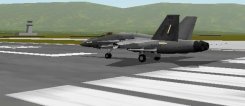
F/A-18 Korea (1997) was one of the first sims to utilise 3DFX.
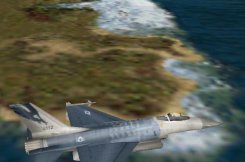
Novalogic's F-16 MRF (1998) made expert use of the 3DFX cards to produce startling terrain.
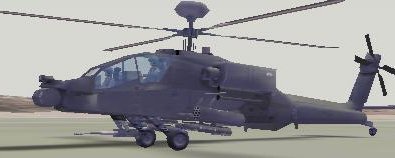
Longbow (1996) by Janes Combat Simulations was updated as Longbow 2 in 1997 to take advantage of the new 3dFX technology.
| 1980 | 2005 | |
|---|---|---|
| CPU Clock speed | 1 MHz | 3,000 MHz |
| RAM | 1 K | 1,000,000 K |
| CPU (Central Processing Unit) | CPU had to calculate movement vectors in 3D and draw polygons. | CPU can hand off graphics tasks to the GPU, and then focus on flight model, AI, avionics, ballistics, countermeasures etc. |
| GPU (Graphics Processing Unit) | None. Not yet invented. | 256K RAM. More powerful than the CPU and has chipsets dedicated to various graphics tasks. |
| Frame Rate / sec | 2 to 5 frames/sec was considered pretty good. | 50-100 frames/sec represented not so much an evolution as a quantum leap in capability. |
| Realism | Realism was low. "Pseudo 3-D" and simple polygons were all the computers could calculate at that time. | Realism was high in some or many areas, depending on the focus of the simulation. Near cinema quality graphics generated in real time. |
 |  |
